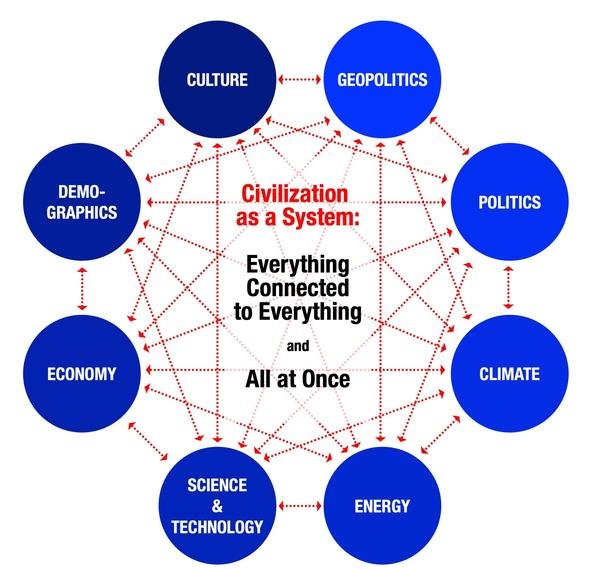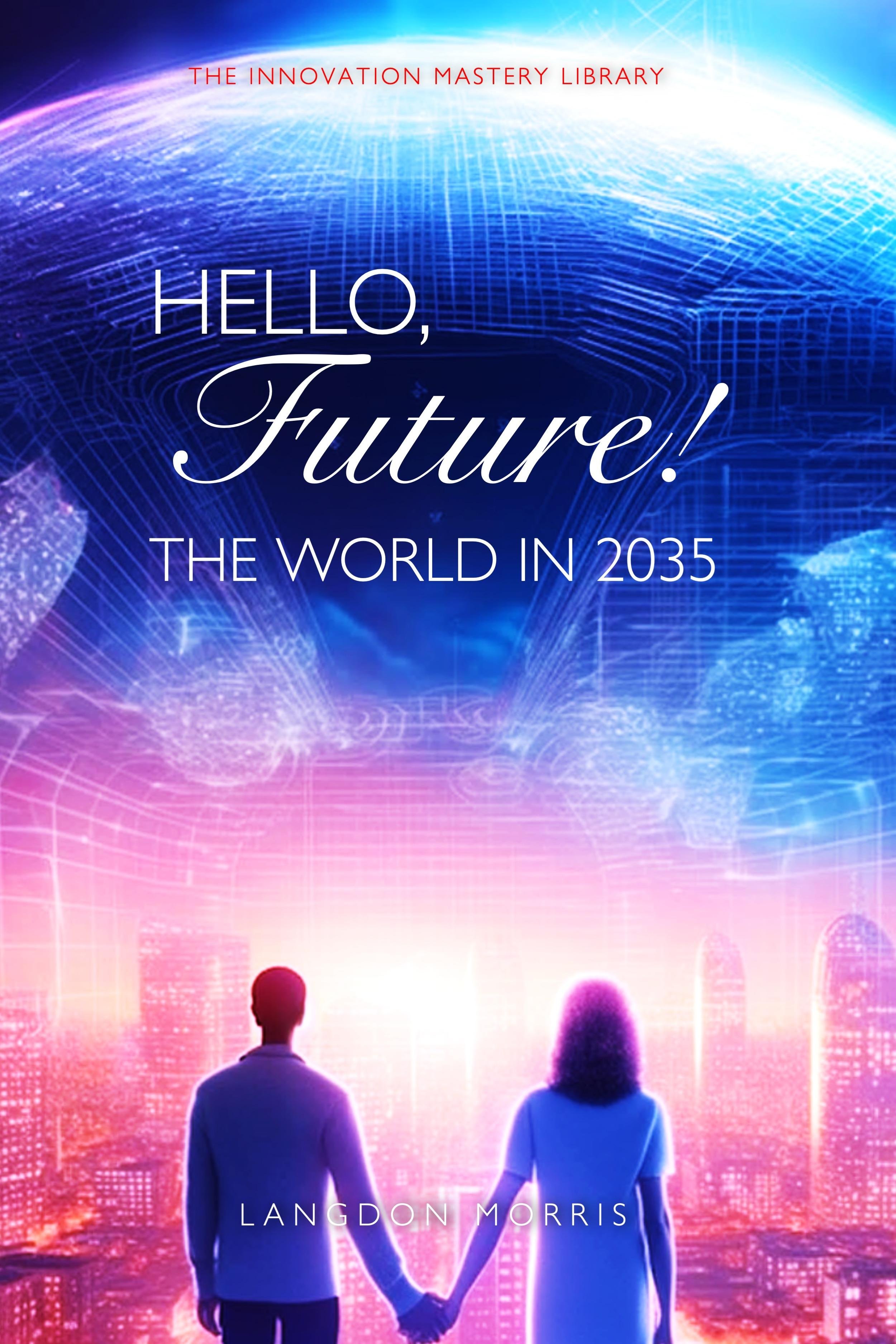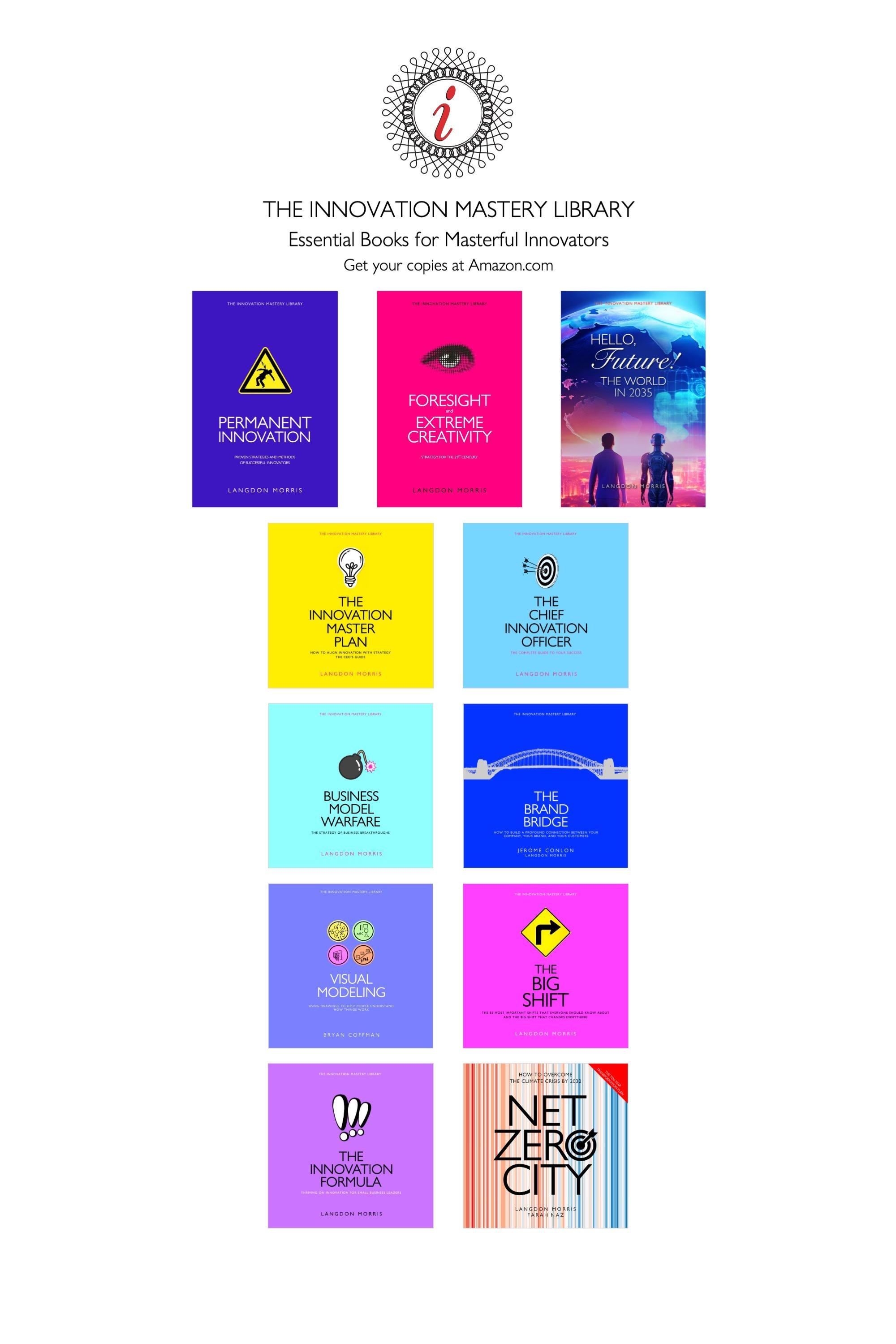EARLY WARNING July 2024
Now that Hello, Future! The World in 2035 has been completed and released (did you get your copy yet?), we have a useful framework for mapping the patterns of change and tracking the trends that continue to shape them.
In case you haven’t looked yet, the book (which is based on work we’ve done over the past decade with major corporations, start-ups, governments, and NGOs around the world) seeks to identify the most significant driving forces that are shaping our era. It focuses on these eight:
A major portion of the book is organized around 32 “What-if” discussions that explore critical facets of each of these eight.
And one of the key points is that all of them are right now (!) in the process of undergoing major changes. Indeed, so much so that within a decade all will be in a significantly different state than they are today. Hence “The World in 2035,” which will vastly different than our world today. But how?
Yes, that’s the poignant question!
And that’s exactly what the book explores.
•••
So now that we have a framework for thinking about change, we’re gathering insights that help us to see which way we’re heading. As such, the title of our newsletter is henceforth going to be “Early Warning,” and its goal is to help you see a bit more clearly into the foggy mists of tomorrow.
Accordingly here are a few observations complied from the last couple months that we found particularly interesting:
Geopolitics:
Here is the incoming prime minister of Singapore, Lawrence Wong, on the current geopolitical situation: “The established norms are eroding. People are searching for new bearings, but the new order is not yet established. I think it will be messy for quite a few years, maybe a decade or longer.” This fits well with the analysis as presented in Hello, Future!, that we are right now in a transition period, and while the old ways have eroded, the new ways are not yet clear.
Russia’s invasion of Ukraine ended a period of 75 years of peace between the major powers of Europe. It altered the defense strategies of NATO and its members and holds massive implications for the future. But how it will unfold remains entirely unknown.
Meanwhile, China’s continuing aggression toward Taiwan threatens to do the same in the Pacific. Yet this month China’s leader, Xi Jinping altered his public position. After threatening for years to invade, he suddenly switched and said that the US was to blame, that the US was trying to goad China into an invasion, but that China would not take the bait. Has he decided that an invasion isn’t going to happen, and placing the blame on the US? Or is this merely another ploy?
Only time will tell, but if China were to invade, the consequences would be as decisive for the status of the world order as Russia’s invasion of Ukraine.
Thus, between the uncertain status of the situation in Ukraine and its vast implications for Europe, and the similarity uncertainty regarding Taiwan, we can only agree with Prime Minister Wong: it’s all in flux.
Economy:
The same is true with the economy. For instance, after growing steadily for decades, global capital flows as a percent of GDP have declined significantly since their recent peak in 2020. This is another bit of evidence that companies and nations are pulling back from globalization, and focusing instead on domestic economies. It’s also a consequence of geopolitical turbulence, increased nationalist economic policies and trade barriers, and the declining influence of global institutions such as the World Bank.
All of it will contribute to a slowing of economic growth globally, and weakening of geopolitical ties. Indeed exports as a percent of GDP have also been flat since about 2008.
This is one symptom of a larger hypothesis presented in Hello, Future! The book suggests that the global economy is in the midst of a process of fundamental restructuring, and in that context these indicators are symptoms of a broader change. Major factors contributing to the economic restructuring in addition to the unsettled geopolitical situation include technological advances such as AI, robotics, and digital commerce, the energy transition now in full force due to both economic factors and climate change, and global demographic shifts.
It is, above all, the convergence of all these driving forces that is causing our era to be so unsettled, which is in turn driving our unsettled politics, with populist demagogues seizing upon the opportunity of crisis to gain power.
Interestingly, while all this big picture change is happening, a so-called “low-altitude economy” is emerging, based not only on drones, but now also on electric flying cars. This is a field in which China already has a big lead, and is making considerable progress, both in terms of the technology and the necessary regulatory frameworks. (The technical term for flying cars is “eVTOL,” or electric vertical take-off and landing.) eVTOLs will not have major impact any time soon, but their emergence is yet another example of the impact that new technology can have on lives and lifestyles.
Climate:
In June the government of Panama starting relocating 300 families from one of its small Caribbean islands to new, government-built housing on the mainland. The reason, of course, is that their island is getting swamped by the rising ocean. 37 additional islands nearby will also eventually have to be evacuated. This is just the tip of the iceberg, as the UN estimates that across Latin America and the Caribbean, 41 million coastal dwellers are similarly threatened.
Among them and a bit further north, the US government is predicting that this year will see the most active hurricane season ever recorded. Sea-surface temperatures in the North Atlantic Ocean in May were hotter than any May on record, and in the Mid-Atlantic the temperatures in May were already as warm as they normally have been in August. This does not bode well for those who live in the Caribbean or on America’s southern coastline. Nor for the insurers, who are likely to take a massive hit when the bill for the damage comes.
Meanwhile, in May the governor of Florida signed a law which removes most references to climate change in state law. He seems to believe that not talking about it will make it go away, a nonsensical position that reflects the worsening culture war that has beset America, and which is now on full view as we enter the thickest part of the presidential election cycle.
Energy:
Wind turbine technology has advanced considerably in recent years. The amount of energy that they generate is a function of the length of the turbine blades, and blade lengths have now reached 120 meters long to generate 15 megawatts of electricity per turbine. The catch is that 120 meters is too long to transport on most road networks, so now turbine builders are experimenting with a variety of solutions, including 3D printing the blades on site, helium airships to deliver blades, and giant cargo airplanes twice the size of a Boeing 747 to deliver them. The only way these massive investments work is if the returns in the form of cash generated are also massive. Which they are.
The wind story complements the solar story, which is also in the midst of a huge wave of investment. Around 600 gigawatts of solar generating capacity will be added this year, about 700 times more than was added during all of 2004. This massive expansion is having major impact on the price for solar panels, creating a positive feedback cycle whereby more demand leads to more production, more production means lower unit costs, which stimulates more demand. Over the course of a few years this has significantly improved the economics of solar, and suggests that in a couple decades solar power will be humanity’s predominant source of energy.
Next up, then, will be the requisite battery storage to make it useful around the clock, along with upgrades to the grid to enable it to move from dry and hot regions to wherever else it’s needed.
All this suggests that the energy transition has become a matter of simple economics, but it, too, has broad implications for the economy, society, and of course the climate.
All of which are issues that we will continue to follow, and which we’ll be updating you in future editions of this newsletter, Early Warning.
Along the way, we’d love to have your feedback – please email your comments to LMorris@innovationlabs.com.
•••
Reader Feedback
We’re very happy to report that we’ve already gotten some very positive responses to Hello, Future!
Here are a few samples from around the world …
Eric Bakey of Boeing in USA wrote this review on Amazon: “Langdon is a futurist, optimist, and a fantastic author. The book provides accurate visual models for where we are, how we got here, and a way forward without being "prescriptive" or politically biased. The book is very thought-provoking and provides tools for choice creation at multiple levels of organization/global collaboration.”
(Eric also has a YouTube channel and he interviewed Langdon about the book. You can see it here...)
Grant Minnie of Propella Incubator in South Africa wrote, “Langdon has the uncanny ability to unravel complexity in order to help us better understand and create our futures. He is proficient at identifying and unravelling those systemic drivers that impact our future, in an experiential way, which culminates in an exceptional read. The scenarios that unfold are thought-provoking and riveting. As a futurist, Langdon grasps the necessity to understand long-term cycles and patterns of change, the drivers of change and connected concepts that are pivotal to better understanding the future. He nails it with proposing a practical framework to manifest counteractive strategies that will aid us in welcoming the future. This text is for both the coffee-table and institutions of learning.””
Albert Yeo, Senior Director of Temasek Polytechnic, Singapore writes:
“Langdon is an exceptional futurist, with a keen eye for an emerging future. I especially like the section on Scenarios of the Future, where he expounded a concept using the dualism ends, which allowed multiple possibilities along the continuum. The book is an easy read, but it necessitates a deeper reflection to truly understand the insights Langdon is putting forth. Truly a thumbs-up!”
On Amazon France, Eric Stone has written a very long 5 star review. Here is an excerpt: “Hello Future, the World in 2035" by Langdon Morris is compelling, thought-provoking, and brilliantly avant-garde! Put simply, Morris has masterfully performed a deep and objective historical analysis of where we are as a civilization and how we got there over the centuries. All the tough but necessary questions are poignantly posed, now and from the future. This book abounds with profound insights into the inner workings of our cultures in their pivotal dimensions about our future.”
Does this inspire you to get your own copy? We hope so … You can get it here (if you’re in the US).
•••
Thank you as always for your attention.
And as always we welcome your feedback as well!
The Innovation Mastery Library
Hello, Future! is the latest addition to The Innovation Mastery Library, now consisting of eleven great books and six outstanding workbooks.




